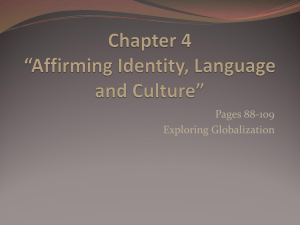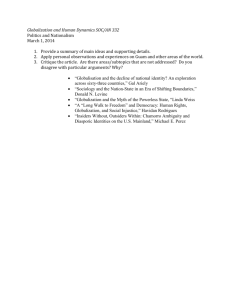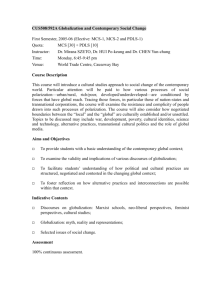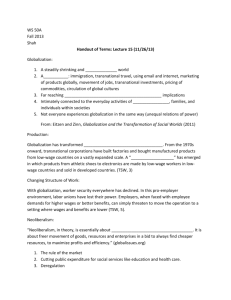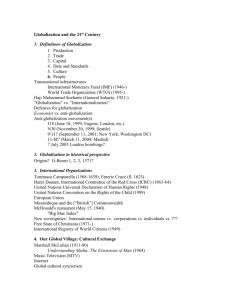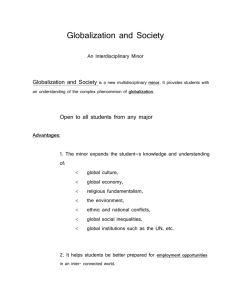Unit One - SharpSchool
advertisement
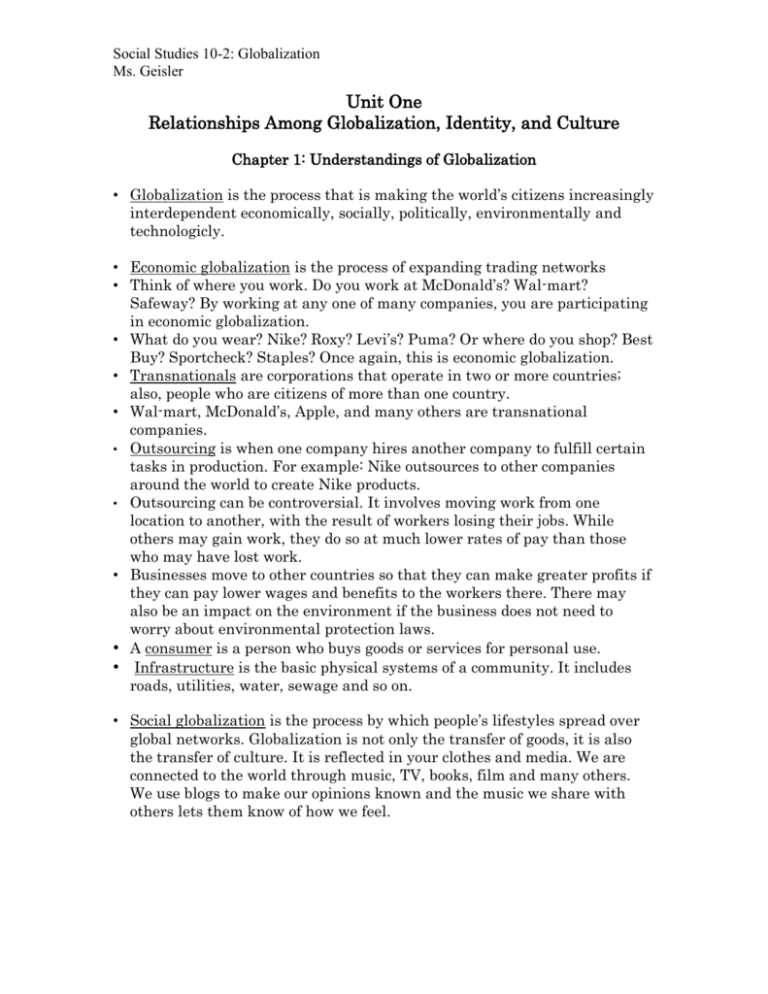
Social Studies 10-2: Globalization Ms. Geisler Unit One Relationships Among Globalization, Identity, and Culture Chapter 1: Understandings of Globalization • Globalization is the process that is making the world’s citizens increasingly interdependent economically, socially, politically, environmentally and technologicly. • Economic globalization is the process of expanding trading networks • Think of where you work. Do you work at McDonald’s? Wal-mart? Safeway? By working at any one of many companies, you are participating in economic globalization. • What do you wear? Nike? Roxy? Levi’s? Puma? Or where do you shop? Best Buy? Sportcheck? Staples? Once again, this is economic globalization. • Transnationals are corporations that operate in two or more countries; also, people who are citizens of more than one country. • Wal-mart, McDonald’s, Apple, and many others are transnational companies. • Outsourcing is when one company hires another company to fulfill certain tasks in production. For example: Nike outsources to other companies around the world to create Nike products. • Outsourcing can be controversial. It involves moving work from one location to another, with the result of workers losing their jobs. While others may gain work, they do so at much lower rates of pay than those who may have lost work. • Businesses move to other countries so that they can make greater profits if they can pay lower wages and benefits to the workers there. There may also be an impact on the environment if the business does not need to worry about environmental protection laws. • A consumer is a person who buys goods or services for personal use. • Infrastructure is the basic physical systems of a community. It includes roads, utilities, water, sewage and so on. • Social globalization is the process by which people’s lifestyles spread over global networks. Globalization is not only the transfer of goods, it is also the transfer of culture. It is reflected in your clothes and media. We are connected to the world through music, TV, books, film and many others. We use blogs to make our opinions known and the music we share with others lets them know of how we feel. Social Studies 10-2: Globalization Ms. Geisler • Television and Internet have created a woven world, especially TV. It has crept into our homes and it has both negative and positive consequences on society. The positive aspect of the television is that it connects us to the world. We are able to see what is happening around the world without having to travel there. Negatives aspects are that it disconnects us from the “real’ world. People fail to participate in the living culture around them and there is the fear that they may lose their culture. • How does the media influence your language, attitudes and ideas? • Think of 5 ways that media has influenced you. • Political Globalization is the process by which political decisions and actions are becoming increasingly international. The Canadian government along with many other governments around the world are required to follow international law. Canada for example, has signed agreements with other nations in regards to military, peacekeeping, and humanitarian ventures. Canada is part of NATO (North Atlantic Treaty Organization), the United Nations, NAFTA (North American Free Trade Agreement) and G8 (Group of Eight). • There are some negative effects on politics when it comes to globalization. One examples of this is the power of transnational companies. Through international trade agreements, transnational companies are gaining protection of their “rights.” • Some of the positive effects of political globalization would be humanitarian ventures. For example, when the 2004 tsunami hit Asia, governments and people around the world joined together to raise money for the victims. In Canada alone, Canadians raised $137 million. The government matched this amount. Another example is when the USA went to war in Iraq. Protests were held around the world preventing many countries from going to war as well. Social Studies 10-2: Globalization Ms. Geisler Chapter 2: Identity and Culture in a Globalizing World • Identity is: Is how we see ourselves and how others see us. Our identity is influenced by our language, traditions, beliefs, etc. Our identity is constantly changing as we grow • Traditions are ideas, practices, beliefs, knowledge, and customs that are passed down through a family, group, culture or religion. • What are some examples of this? Hanukkah, Christmas, Ramadan. Ukrainian Christmas, Chinese New Year, wedding traditions. • Religion is believing in a superhuman controlling power. • Most cultures have a religion • Examples: Hindu, Islam, Christianity, Judaism, Shinto, Buddhism, spirituality. • Attire: Includes clothes, jewellery and other forms of body decoration. Things such as tattoos, piercings, and hairstyles also reflects your identity. • Language is: a method of human communication, either spoken or written, in which words are combined in an agreed way. Every culture/group has a different language. Some use slang or combine two languages together. • The Arts can be found in artwork, music and literature. • Every culture has some form of art, their own music and literature • Collective Identity is: The common characteristics and values used to define a group. What are some examples of collective identity? Canadiens – Francophone descendants of the colonists of New France. Metis – those who are descendants of European and First Nations people. They share many characteristics such as language, traditions, religions, etc. • Linguistic Identity is: Canada is a bilingual nation. This means that both English and French are Canada’s official languages. Francophone is someone whose first language is French. Anglophone is someone whose first language is English. Social Studies 10-2: Globalization Ms. Geisler Chapter 3: Technologies and Promotion of Culture in a Globalizing World • Popular Culture: Everyone has an impact on popular culture. What you choose to buy, say, read, watch and wear affects pop culture at any time. • Universalization of Popular Culture: This is the production by media transnationals of the majority of television programs, films, magazines and so on that are consumed by a vast world audience AOL/Time Warner, Disney, and GE all are transnational media companies that influence and universalize pop culture. They own many smaller companies. For example, AOL/Time Warner own Atlantic Music and HBO among many others. • Advantages of Transnational Media Companies Read Page 50 and copy the 3 advantages in your own words into your notes. • Concerns of Transnational Media Companies Read Page 50 and copy the 3 concerns in your own words into your notes. • Canadian Film vs. American Film Why do we not watch more Canadian Films? Is it because we don’t like them or that we don’t always have the choice? Many US Films are made and distributed by transnational media companies. Many Canadian films are not made by transnational media companies. They are independently produced and distributed. Most theatres are owned by transnational media companies and will not show the independent films. • Hybridization This occurs when people mix traditional arts, mass communication, and popular culture in new ways. What are some examples of this? List them. Social Studies 10-2: Globalization Ms. Geisler Chapter 4: Global Challenges • Homogenization: Is the process by which cultures become more alike in terms of values, attitudes, beliefs, customs, language and traditions. How do the youth around the world dress? Do you share the same style, enjoy the same music, have the same media icons? Many people share these things meaning we’re becoming more homogenized. • How many women of all ages carry a purse as big as this one in Canada? • Picture is from Italian Teen Vogue. • Assimilation: Is the process by which a minority culture adapts a dominant culture and is absorbed into it. It often involves the loss of a language. Things that once made these cultures different have now disappeared. Language is sometimes one of the first things to go. • Challenges of Assimilation: The Francophone community of Alberta has face many challenges in regards to assimilation. They have fought to keep their distinct society. French immersion schools are schools that are designed to teach French to students whose first language is not French. A large part of the curriculum is taught in French. In these schools, the focus on Francophone culture was lost and Francophone students were still assimilated into the majority culture. Francophones realized that they needed Francophone schools. These are schools that are designed to teach Francophone students about their own language, culture and identity. • Marginalization: Is when a group of people is placed into a lower or powerless position within society. It occurs when a society fails to value the identity or culture of a smaller group within the society. An example of this in Canada is the Inuit. During the 1850s to the present, companies searched the north for minerals and oil. While on this quest, they failed to recognize the concerns of the Inuit. The Inuit negotiated with the federal government for self-government and land claims in the North. On April 1, 1999, Nunavut was created with a government that is based on traditional Inuit values. Social Studies 10-2: Globalization Ms. Geisler • Accommodation: Is making adjustments or reaching compromises to allow for differences. For example: McDonald’s accommodates to many cultures. Beer in Germany, Tofu and chicken in India and eggs on double cheeseburgers in Japan. www.mcdonalds.com • Integration: Is providing equal opportunity for participation of different groups in society. For example: The RCMP allowing Sikhs to wear turbans rather than the traditional hat. Chapter 5: Global Opportunities • Acculturation: A change in an individual or a group that results from contact with another group. It is the process of adapting to a new society. Sometimes it can lead to assimilation. Urban Centres • Urbanization: the process by which so many people move into rural areas close to existing cities that these areas become urban. • Industrial Revolution: rapid transition from an agriculture based economy to a manufacturing based economy. • Metropolis: A large, busy city, especially the main city of a country or region. E.g. Edmonton and Calgary, Saskatoon. • Megacity: An urban city with a population of 10 million or more. E.g. New York, Los Angeles, Cairo, Mumbai, Tokyo. • Cultural Revitalization: This is an effort to restore new life to a culture. One uses technology and globalization to restore ones culture. The Acadians use their language, create drama and literature in their own language, pass on traditions, heritage, and language to their children, and they stay connected with other Acadians. Social Studies 10-2: Globalization Ms. Geisler Chapter 6: Promotion of Culture and Language Official Languages Act: • Was passed in 1969 because the government felt that the French Language was not considered equal in Canada. • It was created to help preserve and develop official language communities • Promote the equality of the English and French languages in Canadian society. • In 1988, the government introduced a “new” Official Languages Act that honoured the original act but also added to it. • The new Act stated the government’s commitment to promote bilingualism in Canada and to support the development of official language minority communities. Minority Language Education Rights • In the Canadian Charter of Rights and Freedoms, Section 23 deals with minority language education rights. • This section gives parents who belong to the official language minority in their province the right to have their children education in their first language. • This means that all Francophone parents in Alberta and all Anglophone parents in Quebec can all access that right (as long as the number of students allows for this). Cultural Legislation and Revitalization of Cultures and Languages • The CRTC (Canadian Radio-television and Telecommunications Commission) is an independent public authority. It’s purpose is to regulate and promote Canadian culture on TV and radio. • The CRTC must ensure that Canadian programming reflects: Canadian creativity and talent Our linguistic duality Our cultural diversity The Aboriginal peoples of Canada Our diverse social values Arguments for and Against the CRTC • Read page 95 and write down arguments for and against the CRTC into your notes. Social Studies 10-2: Globalization Ms. Geisler The CBC and SCR • The CBC (Canadian Broadcasting Corporation) and the SRC (la Societe Radio Canada) are Canada’s national broadcasters. • They provide programming with a diversity of cultures within Canada. • E.g. Corner Gas, Little Mosque on the Prairie. Asian Television Network • The ATN is a network that promotes Asian cultures in Canada. It promotes the use of languages to communities across Canada. • An example of this is the showing of Bollywood films on this network. APTN • The APTN is the Aboriginal Peoples Television Network. • It promotes Aboriginal languages and cultures. It provides programming such as Moccasin Flats, which is a show about Aboriginal teens and the difficulties they face.
